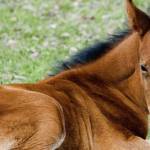Mild Cleft Palate is Reparable in Horses

During normal fetal development, the right and left sides of the horse’s palate (roof of the mouth) fuse to form a solid barrier between the oral cavity and the nasal passages that lie above it. In rare instances (one to two cases per thousand), the fusion is incomplete. Foals with this condition are said to have a cleft palate, a defect that is also found in other animals including humans. Prognosis is poor if there is a large opening in the palate, but less severe cases can sometimes be repaired surgically, giving foals a chance for a normal and productive life.
A cleft palate is usually evident when a newborn foal nurses because milk is pushed through the hole and drips from the nostrils. A veterinarian can assess the size of the hole and can recommend the best course of action.
Large clefts are often difficult to repair, and euthanasia may be the recommendation for severely affected foals. Smaller defects are somewhat easier to repair, though the surgery is not always successful and the procedure may have to be repeated. Leaving the cleft unrepaired puts the foal at a high risk for pneumonia caused by food being pushed into the respiratory tract. Even after surgery, some affected foals have trouble eating properly and may not grow or develop well.
Complications from surgery include infection and failure of the repaired area to remain closed until the tissues can heal. Foals are usually placed on antibiotic treatment and allowed to nurse but are not given access to grass, hay, or grain until healing is progressing well, usually several weeks after surgery.
A study of 55 foals was conducted by The Ohio State University and Rood and Riddle Equine Hospital. Of these foals referred for evaluation because of cleft palate, 13 died or were euthanized before treatment. Corrective surgery was performed on 26 of the foals, and the others were treated with medication and supportive therapy. In 46% of the foals that were treated surgically, small sections of the repaired area came open later.
Among 33 foals that were intended for racing careers, about half were treated surgically. Of those that underwent surgery, two died; two eventually entering race training; and the others recovered but did not race. Two of the non-surgery foals also went on to race. Twelve of the foals that were not of race breeding were treated surgically, and 11 of these survived to discharge.
Foals that were followed until the age of two had good body condition, indicating they were able to eat normally. Some of the young horses had a mild nasal discharge. As a group, horses in this study had a higher survival rate and fewer complications than expected.








